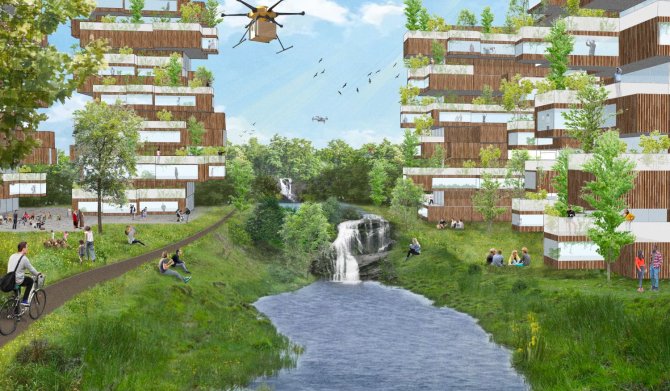Wageningen's Landscape Architecture group is internationally renowned and has the world's largest number of publications in this domain. Is there room for improvement? Certainly, says Sanda Lenzholzer, who has headed the group for the last two years. In her inaugural address, which was postponed due to the pandemic, she introduces her perspective on the group's endavours.
'It was a baptism by fire', says Prof. Dr. Sanda Lenzholzer. She has held the position of professor in Landscape Architecture for two and a half years now, which is approximately how long the most stringent coronavirus measures were in effect. The lockdowns caused her inaugural address to be postponed until 16 June. In that adress she reveals her vision for leading the group.
Innovative solutions in landscapes
The concept of 'deeply integrated design' is central to her vision. Simply put, it means a landscape design in which a variety of topics are included and linked, those could be issues like heat stress, biodiversity, nitrogen emissions, circular agriculture and renewable energy. An example of such an integrated design is the perspective for the city of the future, designed by Lenzholzer and her colleagues: 'The city of 2120: naturally!' In this design, the researchers show how integrating these issues generated very innovative solutions.

'We used Arnhem as an example of a city where two major Dutch landscape types meet', Lenzholzer explains. 'From the hills of the Veluwe, the Arnhemmer creeks descend towards the lower Rhine. Adding dams and ponds to these creeks could facilitate water infiltration into the dryer sandy soils. Moreover, the sluices could be opened during heatwaves to create small waterfalls and thus cooler spots. The new design for stream basins also allows the nocturnal breeze to relieve heat stress in adjacent neighbourhoods. Moreover, it provides space for slow traffic, leisure and biodiversity.'
A flow of energy is also a source of energy
Landscape architectures face significant challenges, such as dealing with the loss of biodiversity and the effects of climate change. 'But there are also opportunities', Lenzholzer immediately adds. 'New technologies for, for example, generating renewable energy and sustainable farming also demand room within a landscape. Landscape architects are not just involved in solving problems but focus on new opportunities. We are genuine optimists who focus on creating a new future.'
'A landscape is made up of living systems and processes which must be included in the design.' Lenzholzer aims to advance what she calls "aircape" within the domain of landscape architecture. Airscape is composed of the various energy flows in the landscape, such as wind and temperature. 'They are invisible, which is likely why not much research is done on them. But they are perceptible to everyone. For example, if you walk close to the high buildings on Wageningen Campus, there is more wind. This is the result of the design. An annoying energy flow such as this can also be used to generate energy. Thus, it is also an energy source.'
Research through design
'Wageningen landscape architecture has a strong scientific tradition. More than is the case in other landscape architecture schools,' Lenzholzer states. 'We are way ahead of the rest in terms of publications and citations.' In order to remain ahead internationally, Lenzholzer continues to seek new, leading experts. Moreover, landscape architecture also offers plenty of opportunities for multidisciplinary collaboration within so-called 'research through design'. Lenzholzer was able to further develop this method within landscape architecture. 'We were able to acquire some wonderful projects in this domain.'
Wageningen landscape architecture has a strong scientific tradition
'We make our designs the subject of research.' Alternatives to a spatial plan are subjected to scientific research methods. As an example, Lenzholzer describes a green street profile that is designed in different ways, after which the various alternatives are run through computer simulations to determine their effect. 'This provides us with legitimate and trustworthy data, something that is of great value in our democratic society.'
Civilians can be included in the testing process. 'The project In my backyard, please considers the deployment of solar panels in collaboration with civilians. There are many ways to work with ordinary people because our designs capture their imagination.'
Sanda Lenzholzer
- Studied Landscape Architecture in Hannover
- Studied Urban Planning at the Architectural Association School of Architecture in London
- Worked at various Landscaping agencies on the intersection of urban planning and landscape architecture
- Took a researching and teaching position at WUR's Landscape Architecture group in 2004
- Obtained her PhD on microclimate at WUR in 2010
- Was appointed chair-holder of the Landscape Architecture group in 2020






